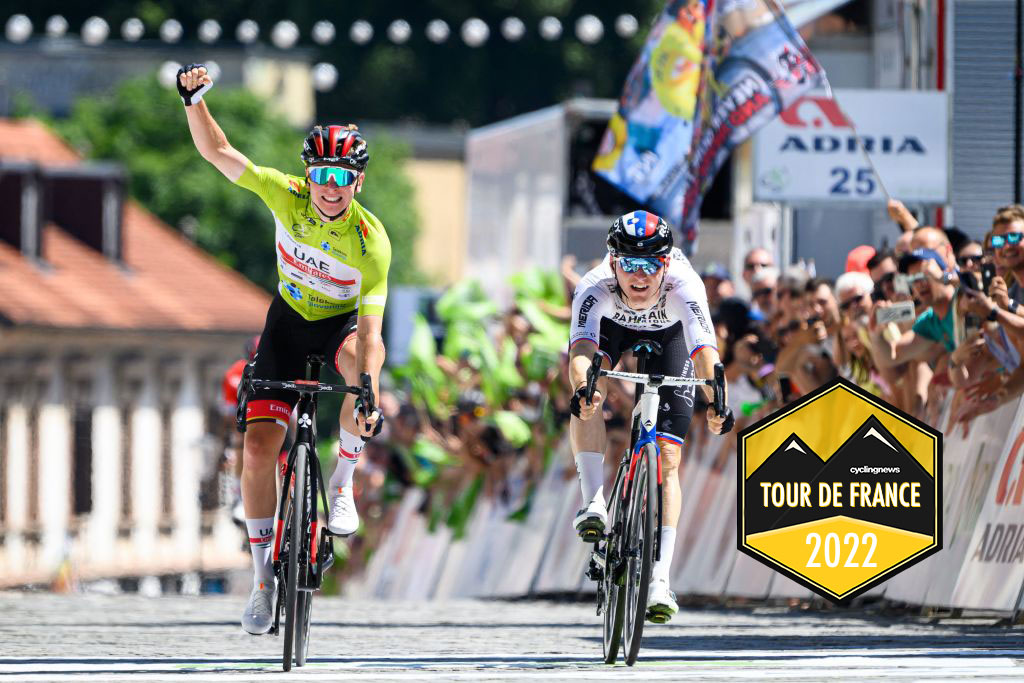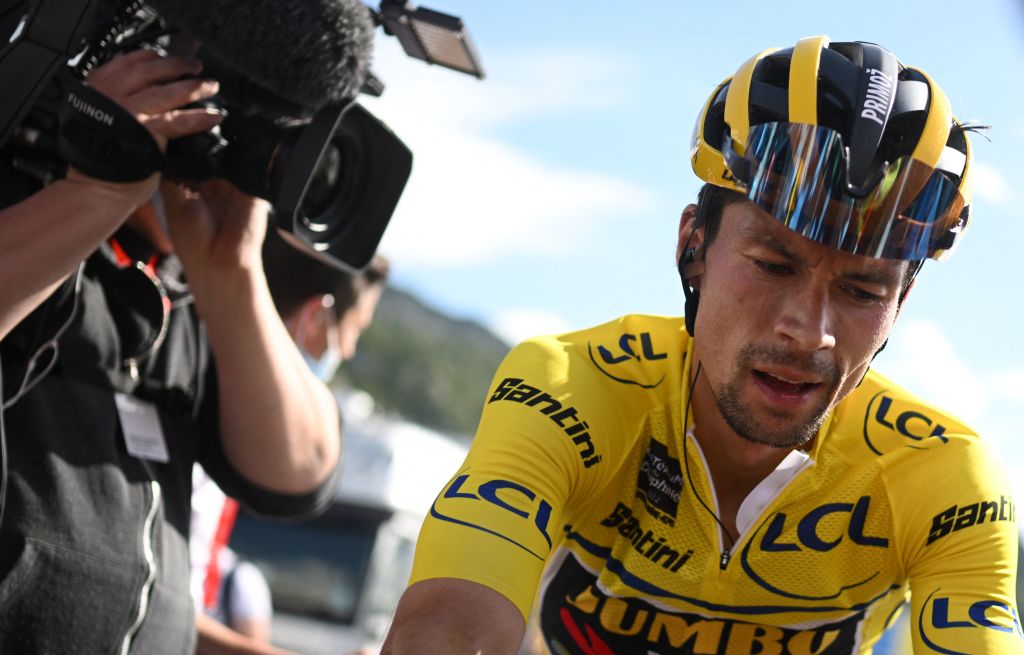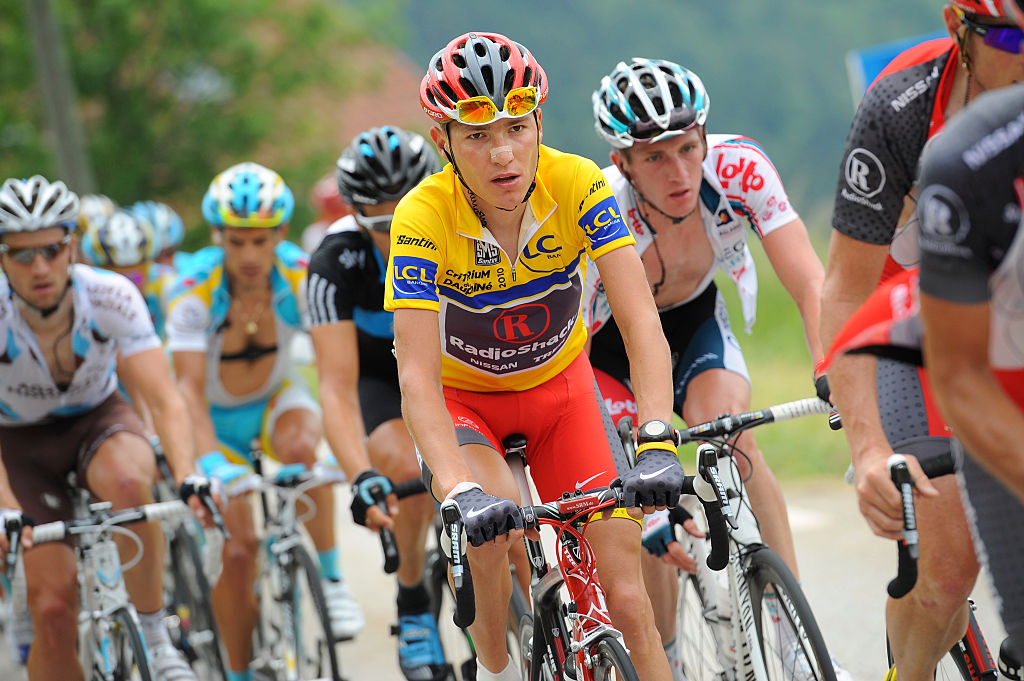How did Slovenia rise to the top of WorldTour cycling?
The storied history behind the meteoric rise of the country which now dominates the Tour de France

One of the most pervasive myths in cycling is that Slovenian cycling came out of nowhere.
Whether you believe that it came out of nowhere when Tadej Valjavec and Janez Brajkovič were delivering Tour de France top-10s a decade and more ago, or whether you believe it started with Primož Roglič's ascendency shortly afterwards, you would be wrong on both counts.
The truth of the matter is cycling has existed in Slovenia as long as cycling itself has existed. A recent testimony to this fact comes in the form of an exhibition at the Ljubljana City Hall titled 'From the Oldest Wheel to the Top of the World of Cycling', curated by the journalist Mark Koghee.
Koghee has been doing research on the origins of cycling and the rise of the sport in Slovenia, specifically in Ljubljana, for the last two years, and much of the information he's gleaned is new to both Slovenians and English-speakers alike. His work shows, for example, that cycling came to Slovenia – then a part of the Austro-Hungarian Empire – via Austria, and that the first cycling team, the Laibacher Bicycle Club, were Germans who established themselves in Ljubljana in 1885. Ivan Tavčar, who would become one of the most famous mayors of Ljubljana, once served as the club's president.
"Racing started really early, I mean 1887," Koghee said in an interview for The Cycling Podcast. "We had the first race, a small race, only four kilometers. A year later, another race of four kilometers. But at the end of the century, for instance we had some bigger races, like Zagreb-Celje-Ljubljana, a race of 200km.
"Also around that time, there was a race, Triste-Vienna, that was over 500km. One year, it went from Trieste to Vienna the other year from Vienna to Trieste and one of the editions was won by Josef Fischer, the winner of the first Paris-Roubaix and winner of Bordeaux-Paris."
These local races all but died out as the tumult of the 20th century unraveled life itself. Political systems, empires, nationalities, and economies changed. Sport, including cycling, was interrupted by two devastating world wars, which both affected the region significantly, with Slovenia leaving the Austro-Hungarian Empire in favor of the Kingdom of Yugoslavia, and – during World War Two – suffering occupations by the Italians and Germans before being liberated by Partisan forces who then formed the Socialist Federation of Yugoslavia.
Get The Leadout Newsletter
The latest race content, interviews, features, reviews and expert buying guides, direct to your inbox!
However, Koghee informed me that despite all this tumult, there were still some notable achievements worth mentioning from the interwar period: Slovenians competed in both the 1924 and 1928 Summer Olympics. And, surprisingly, the first Slovenian to ride in the Tour de France was not a rider from the 1980s, but a man named Franc Abulnar.
Abulnar was a Slovene from the Kingdom of Yugoslavia who rode in the 1936 Tour with the Yugoslav national team. He and his teammates had crashed early on in the race and, while Abulnar lasted longer than his compatriots, persevering through nine of the 21 days of racing, he, too, never finished.
The real meat of Slovenian cycling history, however, comes from Socialist Yugoslavia. After the Yugoslav state stabilised in the wake of World War Two, sporting societies began to spring up in haste, including in cycling.
Slovenia's biggest club, KD Rog – which is the parent club of Women's WorldTour team UAE Team ADQ, as well as Tadej Pogačar's youth club Pogi Team and Ljubljana Gusto Santic, BTC Ljubljana Scott and the Maraton Franja grand fondo – was founded in 1949 by a group of workers from the Rog Bicycle Factory. It was the supplier of most of Slovenia's bicycles, many of which can still be seen on the streets today.
Following KD Rog came Sava Kranj (now KK Kranj) in 1956 and Novo Mesto (now Adria Mobil) in 1972. The three clubs made and continue to make up the backbone of Slovenian cycling, with the vast majority of professional cyclists originating from one of them, including the current generation's stars. Roglič rode with Adria Mobil, Pogačar with KD Rog, and Matej Mohorič with KK Kranj.

A socialist history
Under socialism, the riders in these clubs were employed by the factories that made the products the riders were sponsored by, such as Rog bicycles or Sava tyres. Through policies implemented by worker self-management, they received salaries and equipment from the companies themselves – occasionally, they would have to work in the factory when needed, but ultimately they were able to live comfortably as full-time bike racers.
It's a bit of a Yugoslav twist on the practice of socialist sport, and unlike in the Soviet Union, where athletes were trained and supported directly by the state, Yugoslav cyclists were instead sponsored by these companies which were state owned, thus giving the athletes a little bit more freedom.
Still, as Dario Brentin and Dejan Zac wrote in Sport and Socialist Yugoslavia: "These (in)formal relationships between sporting clubs and the political elites would persist until the end of socialist Yugoslavia, while in many cases in the post-Yugoslav space certain continuities continue to the present day."
These continuities in cycling were sometimes material. Riders such as Matej Mohorič and Tadej Pogačar have told Cyclingnews that, when they first started out, the clubs provided everything they needed, even if the equipment was old. But now, as ex-pro Martin Hvastija, pointed out in an interview with The Cycling Podcast, cycling is suffering from a case of "negative selection" where only the wealthy are able to procure the necessary equipment for their children to become cyclists. Perhaps, then, a little bit of socialism wasn't so bad after all, if it gave us the likes of Tadej Pogačar.
Back to Yugoslavia. At the time, the races were local, amateur events with titles like the Balkan Tour, the Tour of Yugoslavia, and Alpe Adria, which later became the Tour of Slovenia after independence. Of these, the Tour of Yugoslavia was the most important, the regional equivalent to the Tour de France. Slovenians (as Yugoslavians) won the Tour of Yugoslavia no fewer than ten times, and among the winners we find some of the foundational names in 20th century Slovenian cycling.
Rudi Valenčič, who won it twice in 1964 and 1968, later made an impressive appearance in the 1968 Olympic Road Race where he finished 16th. Primož Čerin (who won in 1983) would go on to become one of the first Slovenians to turn professional outside of Yugoslavia along with compatriots Vinko Polončič and Jure Pavlič. The latter was a two-time Tour of Yugoslavia winner (in 1985 and 1986) and is most famous for winning the now-defunct intergiro jersey at the 1989 Giro d'Italia.
These races themselves remain in living memory today, and the people who rode and won them are still lingering in Slovenian cycling's current institutions. For example, Gorazd Penko, winner of the Alpe Adria in 1987, is now a directeur sportif at UAE Team ADQ, and Jure Pavlič is now an assistant sports director at Tirol-KTM, the original home of Bahrain Victorious's newest addition, Matevž Govekar.
While these mid-century cyclists lived stable lives in Yugoslavia, they couldn't help but notice that outside, professional cyclists were making a whole lot more money and were able to participate in the biggest races in cycling. Unfortunately, there was a rule that professional athletes, especially footballers but also cyclists, couldn't work for teams outside of Yugoslavia until the age of 28, which for cycling is towards the end of a rider's career.

After the death of Yugoslavia's prime minister-turned-president, Josip Broz Tito, in 1980 things began to liberalise and the first cyclists to turn professional found homes with neighboring Italian teams – owing to the fact that Slovenian cyclists have always participated in Italian amateur races. To give one example, in 1984, Primož Čerin started with the Euromobil-Zalf-Fior (Castelfranco Veneto) team, an important amateur team in Italy, after the team noticed that Čerin had performed well there.
He later transferred in 1986 to Malvor-Bottecchia, with whom he finished 19th in his first ever Giro. Čerin finished his career at Carrera, one of the most iconic teams of the late 1980s, and a team Pavlič would later join as well. Other cyclists like Polončič followed similar paths, though their careers in foreign teams were unfortunately short due to the Yugoslav age restrictions.
In the 1990s, Slovenia gained independence for the first time in its long history, and with it, cycling moved away from the Yugoslav model towards a Western sponsorship model, within which Rog and Sava, for instance, became minor sponsors. However, the Rog Bicycle Company folded in the early 2000s.
Following in the footsteps of their predecessors, the newest generation of Slovenian cyclists began to seek fame and fortune abroad, usually in Italy. It did not hurt, either, that the 1994 Giro d'Italia went through Kranj, thus bringing one of the sport's biggest races through Slovenian borders for all to see. Among these early pioneers were RTV commentator Hvastija, who rode for the Slovenian-Italian Cantina Tollo team, and later Andrej Hauptman, who notably finished third in the 2001 UCI Road World Championships when he was a member of Tacconi Sport-Vini Caldirola.
This, at the time, was Slovenian cycling's biggest road cycling achievement. To give you an idea of the kind of historical continuity we're talking about, Hvastija is also a sports director with the Slovenian Junior National Team and Hauptman is president of KD Rog and a directeur sportif at UAE Team Emirates. Both were responsible for coaching Tadej Pogačar in his most formative years.
Indeed, Slovenian cycling follows a very simple and very long lineage. You can take any rider on the WorldTour and find, through his coaches, directeurs sportifs, and home clubs, your way through generations of riders dating back all the way to the earliest practitioners of the sport.
And even within the small enclave of Yugoslav amateur cycling, cyclists were competing on a high level comparable to that in the capitalist West. Were it not for the disruption of two world wars and the protectionism of Yugoslavia's sporting policies, it is more than possible that a Slovenian cyclist could have made it to the highest echelons of the sport far before the likes of Hauptman, Brajkovič, Valjavec, Roglič, Mohorič, and Pogačar.
The more information is uncovered by journalists and researchers, following the precedents set by Koghee, Alenka Teren at Siol, and Petra Mušič at RTV (to name only a few) the more we see that the Slovenians have been cyclists – great cyclists – all along. The West just hasn't been paying attention.
Kate Wagner is a Chicago-based writer and critic. Her work on cycling can be found in various publications including Procycling. Her newsletter covers cycling in an unconventional fashion, featuring essays, short stories, multimedia works and illustration.
She can be found Tweeting at @derailleurkate